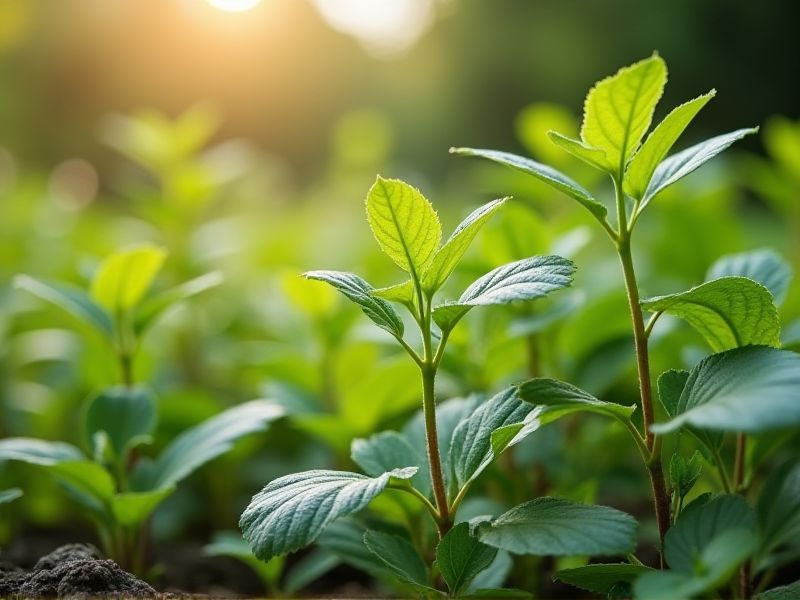
Water-wise plants, also known as drought-tolerant species, are specifically adapted to thrive in arid or semi-arid environments while minimizing water usage. Examples include succulents like agave and aloe vera, which store moisture in their thick leaves, and native grasses such as blue grama, offering resilience with little irrigation. Many Mediterranean plants, like lavender and rosemary, not only require minimal water but also provide fragrance and attract pollinators to your garden. Incorporating these plants can significantly reduce your landscape's water consumption while promoting biodiversity. Choosing water-wise plants enhances sustainability and creates a vibrant, low-maintenance outdoor space.
List of some Water-wise plants that conserve water
- Lavender (Lavandula)
- Sage (Salvia)
- Yarrow (Achillea millefolium)
- Agave (Agave americana)
- Sedum (Sedum spp.)
- Russian Sage (Perovskia atriplicifolia)
- Coneflower (Echinacea purpurea)
- Ice Plant (Delosperma cooperi)
- Red Yucca (Hesperaloe parviflora)
- Blue Fescue (Festuca glauca)
Important things about Water-wise plants that conserve water
Drought Tolerance
Water-wise plants, such as succulents and native drought-tolerant species, are specifically adapted to conserve water in arid conditions. These plants, including agaves and ornamental grasses, have evolved mechanisms like thick leaves or deep roots to minimize water loss while maximizing survival. Incorporating these varieties into your landscape can substantially reduce water consumption, making your garden more sustainable. By choosing water-wise plants, you not only contribute to environmental conservation but also create a vibrant outdoor space that thrives even in dry conditions.
Low Water Requirements
Water-wise plants are specifically chosen for their low water requirements and adaptability to arid conditions, making them ideal for sustainable gardening. Examples include succulents like Aloe Vera and cacti, which store moisture in their leaves and thrive in dry environments. Incorporating native species such as lavender and rosemary not only conserves water but also supports local wildlife and enhances biodiversity. Opting for these resilient varieties in your landscape design can significantly reduce water usage and promote a more eco-friendly garden.
Native Species Compatibility
Water-wise native plants that conserve water are crucial for sustainable gardening and landscaping. Species like California poppy, manzanita, and desert sage require minimal irrigation and thrive in local climates. These plants not only enhance biodiversity by providing habitat for native wildlife but also reduce the need for chemical fertilizers and pesticides. By incorporating native water-wise plants into your garden, you contribute to environmental conservation while enjoying the beauty and resilience of native flora.
Soil Adaptability
Water-wise plants are specifically chosen for their ability to thrive in various soil types while conserving precious water resources. These drought-tolerant species, such as succulents, native grasses, and Mediterranean herbs, are well-adapted to low-water environments and often have deep root systems that access moisture from deeper soil layers. Implementing these plants in your garden not only reduces water usage but also promotes biodiversity and enhances soil health by preventing erosion. Selecting the appropriate water-wise plants based on your soil type can create a sustainable landscape that requires minimal irrigation.
Seasonal Growth Patterns
Water-wise plants exhibit remarkable seasonal growth patterns that align with their environments, minimizing water usage while thriving. These plants, such as succulents and native drought-resistant flora, often enter a state of dormancy during dry seasons, conserving resources and energy. In contrast, they actively grow and bloom during cooler, wetter months, optimizing water uptake and nutrient absorption. By incorporating water-wise plants into your garden, you can create a sustainable landscape that flourishes with minimal irrigation, supporting local ecosystems and reducing water waste.
Mulching Benefits
Mulching around water-wise plants significantly enhances moisture retention in the soil, reducing the need for frequent watering. This practice helps regulate soil temperature, which is crucial for plant health, particularly in arid conditions. Organic mulches, such as wood chips or straw, improve soil fertility as they decompose, promoting robust growth of drought-resistant varieties. By implementing mulching, you can create an efficient garden ecosystem that conserves water while supporting sustainable landscaping efforts.
Deep Root Systems
Water-wise plants, such as succulents and native grasses, exhibit deep root systems that enhance their ability to access moisture from the soil. These roots allow the plants to tap into underground water reserves, making them ideal for arid environments. By incorporating these species into your garden, you can significantly reduce water usage while maintaining a vibrant landscape. Emphasizing drought-tolerant varieties not only conserves water but also supports local ecosystems and biodiversity.
Reduced Maintenance Needs
Water-wise plants are specifically adapted to thrive in arid conditions, requiring minimal irrigation and care. These drought-resistant species include succulents, native grasses, and many perennial flowers that reduce water waste while adding beauty to your garden. Implementing water-wise plants not only lowers maintenance needs but also enhances your landscape's resilience against climate change. By incorporating these plants into your outdoor space, you can create a sustainable environment that conserves resources and fosters biodiversity.
Climate Resilience
Water-wise plants are essential for promoting climate resilience, especially in areas facing drought and water scarcity. These drought-tolerant species, such as succulents, native grasses, and Mediterranean herbs, require minimal irrigation once established, making them ideal for sustainable landscaping. By incorporating water-wise plants into your garden, you not only contribute to water conservation but also enhance biodiversity by attracting pollinators and beneficial insects. Choosing these plants can significantly reduce your water usage while creating a vibrant and thriving ecosystem.
Aesthetic Appeal
Water-wise plants are not only functional in conserving water but also offer stunning aesthetic appeal for your garden. These drought-resistant species, like succulents, lavender, and native grasses, showcase vibrant colors and unique textures, enhancing the visual interest of any landscape. Incorporating plants such as agave and ornamental grasses can create a beautiful contrast while requiring minimal maintenance. By choosing these environmentally-friendly options, you can design a captivating garden that thrives with reduced water consumption, promoting sustainability without sacrificing style.
